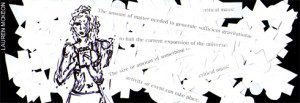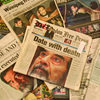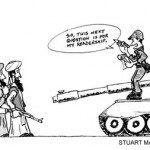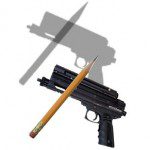Sex in the Newsroom
About to step into a male-dominated industry, Dana Lacey asks female journalists about their careers, their challenges and their aspirations. It all starts with one question: why aren't there more women on top?

Critical Mass: 1. The amount of matter needed to generate sufficient gravitational force to halt the current expansion of the universe. 2. The size or amount of something that is required before an activity or event can take place
Sorry, but there’s no crying in journalism. Sorry, but there’s no part-time position available, it’s 24/7 or nothing. Sorry, but this is a tough job, and you’re just too nice. Sorry, but…
The first thing I have to say is that, while I am a female and a journalist, this is not one of those tired, old-news feminist stories. This is a not a poor-us rant about sexism, or short skirts, or the fact a woman makes 29 cents less on the dollar than a man. That said, this is, in fact, a story about me, about women and our struggles to rise above statistics, stereotypes and the status quo. If you just rolled your eyes, you’re already a part of this story too.
This story started as a research project for class. My group (four women and one man) combed through the mastheads of 35 Canadian newspapers, including the papers with the largest circulations in each province except Quebec. We looked to the top — the coveted Editor-in-Chief job. We started counting the female names, and, well, it didn’t take long: Patricia Graham (The Vancouver Sun), Lynn Haddrall (The Record), Janice Dockham (The Leader-Post) and Lucinda Chodan (the Victoria Times-Colonist). We counted again. Only four? Disgraceful, we thought. Disappointing, discouraging. I had, after all, earned a considerable debt in my quest to be Lois Lane. Surely there were more of us, but where?
We did the research project this year, in the oh-so-modern new millennium, yet men outnumber women in journalism’s highest-ranking editorial job eight to one: Patricia, Lynn, Janice, Lucinda.
The jobs just below — senior management — were a more palatable mix at three to one, implying the existence of the dreaded “glass ceiling.” We looked to department heads: men are eight times more likely than women to be business/technology or sports editors. They outnumber women in news four to one, and there are twice as many male city editors. On the other hand, fashion editors were predominately female (8:1), as well as food/lifestyle (4:1).
For the last decade, journalism schools have been pumping out mostly female graduates — in my class alone women outnumber men five to one. So why, then, are journalism’s top jobs dominated so dramatically by men?
Gertrude Robinson, in her book Gender, Journalism and Equity, says that women are at a disadvantage because journalism promotes “maleness” and “information” as the norm. “[I]t thus enshrines very specific workplace practices, such as a 10- or 12-hour working day, as ‘normal,’ and evaluates ‘entertainment’ as somehow ‘inferior.’”
She goes on to talk about “personality stereotyping,” which sticks women into “a small number of femaletypes, such as ‘mom,’ ‘kid sister,’ ‘girl next door,’ or ‘bitch.’” These are designed to make women less threatening, she says, and serves to exclude them from participating as “full members” of any given group. Think about a strong female professional you know — if you can put her in a category like that you’ve just demoted her to one dimension.
These stats and assessments don’t mean a lot to me. Yeah, sure, they contradict Society, which says women and men are equal, but so what? Women already know that story. My research group could have stopped there, sticking a big ol’ Status Quo in our paper’sconclusion. But I’m not much for numbers or broad appraisals. I needed to talk to some real women.
• • •
Ann Rauhala, a Ryerson journalism professor, has been researching decision-making in Canadian newsrooms for years. In the course of her research she has been struck by the lack of female decision-makers. She can’t speak to me about her research results until they’ve been published, but when I ask her about her personal experience with the subject she gives me the same tired list of problems: a lack of affordable daycare, combined with the fact that child-rearing responsibilities still fall mostly on the mom, and as always, problems with stereotypes. People might assume that, because you’re a woman, you will write, lead or behave a certain way. “An editor took me aside when I had a dispute with a reporter and said I was too nice,” Rauhala explains, rolling her eyes. “Do you know anyone who thinks I’m nice?” She didn’t seem to expect an answer.
Margo Goodhand is the deputy editor at the Winnipeg Free Press. I like her immediately because she says “I don’t want to sound like an old feminist…” before making what is essentially a feminist point about the challenges of being a mother in a demanding, all-encompassing job like journalism. When I gave her my stats-spiel she says, “Wow, that’s not bad. I’m surprised there’s that many.” She goes on. “I’ve known too many talented women who reach a certain level in management and then move on, not up. They look for a more ‘sexy’ balanced job elsewhere, in PR or communications, where they’re working almost as hard, but not 24/7.” In journalism, it’s nearly impossible to get a part-time job as editor — Goodhand works seven days a week these days. When she decided to have children, after four years in journalism, she quit her job as business editor. She worked as a copy editor for eight years (“eight years in purgatory on the night desk”), which gave her more time to raise her three children. “I was home most of the day and worked evenings, when my husband would be home.” Pre-babies, she’d done nearly every job in the newsroom. I ask her if she wants to be EIC — “I do and I don’t…I don’t know if I can take that final step and survive it.”
Then there’s Vancouver’s Graham, arguably Canada’s most powerful female journalist as EIC of our seventh-largest paper. “Women are still learning to play in what was until very recently almost exclusively a male domain,” she says. “It’s not going to transform overnight.” The absence of women in senior positions can have a ripple effect. “The fewer there are, the fewer the role models and mentors to inspire and include other women.”
Graham, originally a lawyer, has been a journalist since the ‘80s. Like Goodhand, Graham sees a lot of women self-select out of the management game for their family, lifestyle or because they simply prefer “on-the-ground” journalism. Graham took three years off early in her career (save one summer) to raise her two small children — she had suddenly become a single mom — and spent another year as a part-time copy editor before pushing herself up the ranks. Unlike a lot of women I talked to, Graham’s career took the logical leaps forward — she has been an editorial writer, editorial page editor, reporter, senior editor in charge of news, managing editor, and, in 2003, EIC. “Societal expectations are still different” between the genders, she explains. “I believe this can make it easier and more acceptable for women than for men to say ‘no thanks, not interested in that.’” She’s modest about her trip to the top in the same way my mom is modest about raising three kids on her own. “I’ve learned that it helps to believe that you’re the best person for the job and be willing to say so.”
Janet Hurley is the Arts and Entertainment editor at the Toronto Star. A Ryerson journalism grad in 1992, her first “real” job was at the Haliburton County Echo, where she was mentored by its female EIC. In 2000, when she was Saturday Arts editor at the Star, her water broke at work — she came dangerously close to having the Star‘s first newsroom baby. When she came back from maternity leave she found that the Star had given her position away and she was shuffled into the Sunday section. Luckily, though, six months later Sunday’s paper got a complete overhaul. Hurley was responsible for the birth of the edgy, popular Buzz section. Today she is the mother of two young girls and pulls tag-team baby duties with her husband, also a journalist — she looks after the kids in the mornings and he takes over when he gets off work in the early afternoon, picking the girls up from daycare. “I’d love to spend more time with my kids, but I also love my job…and it’s important for me to be a role model for my girls.” When I ask if she’s ever considered her gender an obstacle, she says no. When I push a little further, she remembers, before she was at the Star, “Someone once told me I didn’t yell enough to do this job.”
Three women, all mothers, all love their jobs and none are bowled over by some bullshit statistics and their vague “nice” complexes. I think I finally Get It. I’m glad I’m a woman, but the label I fight for is Journalist. And I think, as Goodhand thinks, that I’ll see it in my own time: It’s a simple matter of critical mass.
I’m graduating in less than a month with a class full of eager, competent women. But maybe I’ll stop being nice altogether, just in case.
by Dana Lacey
Dana Lacey was the Online Editor for the Summer 2007 issue of the Ryerson Review of Journalism.












































